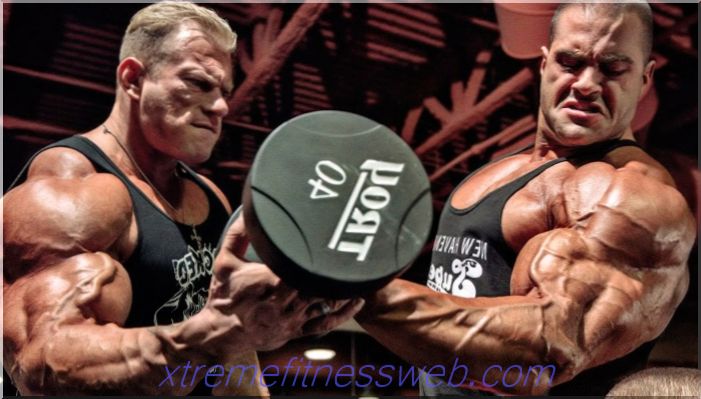- Classic deadlift or sumo - which exercise is better?
- The difference between the deadlift sumo from other variations
- The right traction technique
- Why do deadlifts sumo ">

The similarity of the performance technique with the classic deadlift raises a logical question, but why make a sumo if both options are practically no different. There is a difference between them, and it consists in the setting of the legs.
Increasing the distance between the feet leads to the fact that the projectile rises to a much lower height. Turning the hips out allows you to work out the tendons under the knees well. A narrower stance leads to the fact that the weight evenly loads the calves, buttocks, quadriceps and thighs. A wide position, on the contrary, loads the hamstrings. This makes sumo traction one of the best exercises to work out this area.
The posterior muscle groups of the thighs are involved in the work, but they are worked out a little differently than in other exercises, where the lower part of the body is involved. Being in the rack, which is designed to load the femoral biceps, it should be assumed that the muscles work in an appropriate way. The load is given both on the inner region and on the biceps. Therefore, the implementation of this version of traction helps to engage the muscles throughout the leg, and not just the muscles under the buttocks.
Thanks to the strengthening of the inner thighs, it becomes much easier to perform other exercises aimed at working out the lower body.
What muscles work in sumo traction?
- Who Should Do Sumo Cravings ">

Trying to make a sumo is recommended to everyone. However, given the fact that it is impossible to spend the whole day in the gym, honing one or another version of traction, the exercise should either be added to the main program or performed every few weeks instead of the classical one so that the muscles of the lower body do not have time to adapt to one load and monotonous movements.
A feature of sumo is that it gives a much lesser load on the vertebral region and lower back. Therefore, for those who have suffered an injury or experience pain in this part of the body, this version of the deadlift allows you to train without undue strain on this area, which is an undeniable advantage and reduces risks.
Sample training program
- Summarizing

The largest muscle groups are located in the lower extremities, so developing the legs is no less important than other parts of the body. In order to achieve your goals, doing fitness, you need to constantly learn new exercises, increase stress, which will allow calories to be burned not only during, but also after training.
To diversify the lesson allows the program, which includes the deadlift sumo, which, perhaps, almost everyone has heard of. Exercise has nothing to do with the same type of martial arts. It in no way turns a person into a fighter of impressive size.
The movement is almost nothing like martial arts. Its main feature is that it allows you to work fine legs. Do I need to include this exercise in the training or not ">
Content
- 1 Classic deadlift or sumo - which exercise is better?
- 2 The difference between the deadlift sumo from other variations
- 3 Proper traction technique
- 3.1 Remember
- 3.2 Execution
- 4 Why do deadlifts sumo?
- 5 What muscles work in sumo traction
- 6 Who Should Do Sumo Cravings?
- 7 Sample training program
- 8 Summary
Classic deadlift or sumo - which exercise is better?

It is much easier for novice athletes to perform deadlift classic traction. This is due to the natural position of the joints. Exercise is great for short as well as full athletes. A variety of sumo is more suitable for athletes of high growth, because they get the opportunity to reduce the amplitude of movement and increase the mass of the lifted weight.
This is not the only difference. The classic version allows you to work out more gluteal muscles and, to a lesser extent, the inner thigh. Sumo works the other way around. The inner thighs are used to the maximum, and the buttocks get a minimal load. Therefore, the choice between these variations in deadlift depends on which muscles require more exercise.
It is best, of course, to alternate the options at different stages of the workout. Since, mastering completely any program, there comes a moment of peculiar comfort. The athlete does an excellent job with the exercises. Each movement is brought to automaticity, and the weight lends itself easily. On the one hand, this makes training easier, but on the other hand it is not good.
Changes to the training program are necessary. There are several reasons for this:
- Muscles should always be shocked during exercise. If tension and stress are absent, muscle groups adapt to stress. Volume growth slows down, and strength indicators cease to increase. Consequently, habitual movements no longer shock muscles. They stop in development as the effect weakens. The athlete stops experiencing pain, waking up the next morning after a workout, strength indicators and muscle volumes, if you train regularly, do not increase. Refusal of habitual movements with the addition of new ones brings muscle into tone, because they are constantly tense, which means that volumes and strength begin to grow.
- New movements are important for the harmonious development of the body. Due to the variety of exercises, various muscles are involved, and, therefore, the muscles develop evenly.
It is not necessary to completely change the training program. Movement when changing traction variations means performing several different manipulations and loads. This is quite enough for muscle fibers to be worked out in a different way, to adapt to new loads, and, therefore, grow. The increase in volumes goes with increasing strength. This will not be possible when, when coming to the gym, again and again to do some exercises.
Without making adjustments to your own training program, you cannot make progress. Sooner or later, the moment comes when you have to change the exercises. Otherwise, the next goal will not be achieved. Therefore, the thrust must be performed in various variations.
The difference between the deadlift sumo from other variations

Such a craving got its name “sumo” for certain reasons. Classical variation of execution involves the following actions:
- a pancake bar is in front of the athlete;
- fall, doing almost a squat so that the legs are almost shoulder-width apart;
- take the bar, keeping your back absolutely straight;
- making an explosive movement, the projectile is lifted up, hold the bar with his hands, pushing himself out by the force of the lower body.
Thus, almost all muscle groups of the lower body are involved. The lower back area is also involved in the work. If you need to work out the trapeze, then you should hold your shoulders correctly.
Option sumo is not much different from the classic. The difference is due to the fact that the legs are placed in a slightly different position, which makes the athlete move differently. The staging of the lower extremities led to the fact that the craving was called "sumo." Performing it, the athlete is like a sumo player who is preparing to make a throw.
If you imagine a big Japanese wrestler, he doesn’t just go to battle, but demonstrate his opponent’s determination by means of a pose involving a wide set of legs. This pose distinguishes sumo traction from the classic version. Feet are not only placed wider than the level of the shoulder girdle, but also the hips are turned outward. This position, similar to that adopted by the sumo wrestler, is the starting point in the performance of traction.
The right traction technique

This traction option is not typical. It can be infrequently observed by athletes training in the gym. There are fitness centers where no one practices traction in any variation. For those who make the classic version, which has already become familiar, making a sumo will not be a problem.
Should be remembered
Changing the position of the legs changes the groups of muscles involved. An unusual position requires caution with lifting weights. Those who do this version of traction for the first time should not take the usual mass. It is better to lighten the load in order to feel the reaction of your own body.
Then, having unloaded the bar, they stand in front of the bar. Legs set shoulder-width apart. This can provoke some feeling of tension and tension in the inner thighs. Therefore, if the warm-up was not performed, it is better to warm up a bit first. You can do a few squats from the accepted position. This involves those muscles that will be further developed.
Performance

When the position is accepted, the warm-up is completed, go to the exercise:
- Grasp the bar, keeping your back straight and even. To take the bar, they bend in the lower back. The grip is similar to the classic version when the arms are approximately the same width as the shoulders. There are no strict grip requirements. You can use a variety of variations. It all depends on preferences and your own convenience. Use grip from below, from above, grip. Experiments are permissible.
- Lower, slightly bending the body. Since the staging of the legs is wide, the hips are almost parallel to the surface of the floor. It is imperative to ensure that the back is completely straight, the chest, like the look, is directed forward. Most of the lifted weight falls on the back of the legs. Straighten explosive sharp movement, carried out due to the repulsion of the legs. The bottom line is that the athlete only holds onto the bar, and the projectile is ejected exclusively from the bottom of the body.
At the moment when the bar crosses the knees, the pelvis is pushed forward, the shoulder blades are brought together. Thanks to this movement, the shoulder girdle becomes more elastic. To increase the load and use the shoulders to the maxim, at this point they are delayed, keeping the blades flattened, and only then return to the starting position. It is always necessary to control the position of the body while lowering the projectile. When the bar is again below, it is lifted and everything is repeated from the very beginning.
Why do deadlifts sumo "> 
The similarity of the performance technique with the classic deadlift raises a logical question, but why make a sumo if both options are practically no different. There is a difference between them, and it consists in the setting of the legs.
Increasing the distance between the feet leads to the fact that the projectile rises to a much lower height. Turning the hips out allows you to work out the tendons under the knees well. A narrower stance leads to the fact that the weight evenly loads the calves, buttocks, quadriceps and thighs. A wide position, on the contrary, loads the hamstrings. This makes sumo traction one of the best exercises to work out this area.
The posterior muscle groups of the thighs are involved in the work, but they are worked out a little differently than in other exercises, where the lower part of the body is involved. Being in the rack, which is designed to load the femoral biceps, it should be assumed that the muscles work in an appropriate way. The load is given both on the inner region and on the biceps. Therefore, the implementation of this version of traction helps to engage the muscles throughout the leg, and not just the muscles under the buttocks.
Thanks to the strengthening of the inner thighs, it becomes much easier to perform other exercises aimed at working out the lower body.
What muscles work in sumo traction?

Do not give up the traditional deadlift. It is the best exercise aimed at working out all the muscle groups of the back of the body. It is also impossible to remove the classic version completely, replacing it with another variation. This also applies to sumo. It is best to additionally include it in the training program, since this draft also involves the muscles of the back of the body, but in a slightly different way, which leads the muscles to tone.
Sumo deadlift is directed to the gluteal muscles and hamstrings. They get much more load than with the classical execution of this exercise, that is, with a narrow arrangement of the feet. This is especially true of tendons. In parallel, the abducting muscle groups are also involved. In addition, quadriceps work. How much they are loaded is determined by the width of the legs. At the same time, the forearms are tensed more, since the bar is held by hands.
Secondary muscles are almost all dorsal. At the top point, bringing the shoulder blades together, the athlete loads, and, therefore, works out the trapeze. The stabilizing muscles for this type of traction are the abdominal and diamond-shaped, as well as the hip flexors.
Who Should Do Sumo Cravings "> 
Trying to make a sumo is recommended to everyone. However, given the fact that it is impossible to spend the whole day in the gym, honing one or another version of traction, the exercise should either be added to the main program or performed every few weeks instead of the classical one so that the muscles of the lower body do not have time to adapt to one load and monotonous movements.
A feature of sumo is that it gives a much lesser load on the vertebral region and lower back. Therefore, for those who have suffered an injury or experience pain in this part of the body, this version of the deadlift allows you to train without undue strain on this area, which is an undeniable advantage and reduces risks.
Sample training program

Most weight lifting exercises are included in the training process either with the aim of gaining additional volume, or to increase strength indicators. Beginners should not immediately take on a lot of weight. Begin small. Even experienced lifters are also not recommended to raise the usual mass, as changing emphasis requires adaptation.
If your goal is strength, do 3 sets of 4 reps. This is due to the fact that sumo is not the only traction exercise, so there is no particular sense in striving to give everything in full. If traction is done last during classes, then four approaches can be performed, but for the final one, take lighter weights and bring to twelve repetitions. This loads the muscles to failure and allows you to completely burn all the remaining energy in the workout.
Those who want to increase muscle in volumes, but not increase strength, should do from eight to twelve repetitions. When the maximum number of repetitions is given without any difficulties, then the lifting mass should be increased. The number of repetitions is reduced to nine to ten. You need to do three approaches. Sumo traction is most beneficial only when, after the last repetition, the projectile is no longer strong enough. Otherwise, either the weights are too small, or the number of repetitions requires an increase.
Summarizing
Of the traction exercises, deadlift is one of the best, since it involves the muscle groups of the back region of the body almost completely. The classic variation must be present in the training program of each elevator, but for sumo, it should also take some place.
Unlike traditional traction, sumo works out its buttocks and hamstrings, but from a different angle. This option allows you to do deadlift even for those who avoided this exercise due to injury or pain in the back. It is included in the general training program or periodically replaced with classical traction for sumo to shock muscles.
This option of deadlift should not be neglected. It allows you to diversify your workout, must be constantly or periodically included in the program, if you want to get the most out of the time devoted to physical activity.









